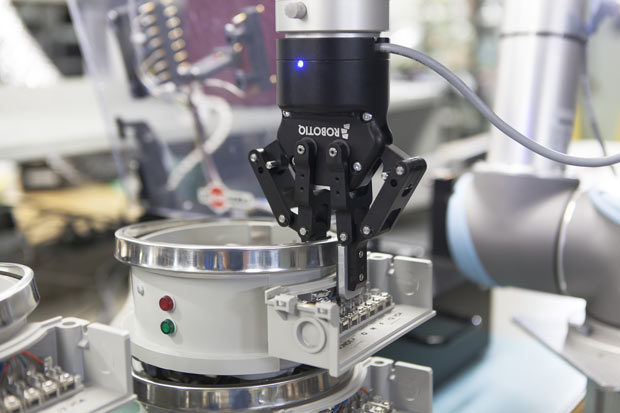Robots Get A Grip

Robotiq’s 3-Finger Adaptive Gripper enables dexterous testing on the production line. Image courtesy of Robotiq.
Latest News
March 1, 2016
 To automate its product testing, a leading manufacturer used Robotiq sensors and components with a Universal Robots arm. Image courtesy of Robotiq.
To automate its product testing, a leading manufacturer used Robotiq sensors and components with a Universal Robots arm. Image courtesy of Robotiq.The Robotiq FT 150 force torque sensor can be used in a lot of applications. From assembly tasks to collaborative uses, the sensor is designed for a range of applications. With the constant quest to bring products with high quality standards to the market, industrial applications have been interested in the use of the FT 150 sensor for quality assurance. Here’s how a leading manufacturer of operator controls, non-contact sensors and safety devices is using the Robotiq sensor in its manufacturing loop.
Application
The joystick bases and control sticks are a main product group from the manufacturer. These products must go through a variety of qualitative and quantitative test procedures. The joysticks are sold as a principle control device for vehicles, and they are a critical component for their customers. The quality assurance team has to verify the conformance of the electronic and mechanical components before they get to final packaging. The quality control team in the past used to test their production manually, which allowed the workers to adapt their verification tasks to dozens of different joystick models including custom configurations.
 Robotiq’s 3-Finger Adaptive Gripper enables dexterous testing on the production line. Image courtesy of Robotiq.
Robotiq’s 3-Finger Adaptive Gripper enables dexterous testing on the production line. Image courtesy of Robotiq.The goal was to monitor the performance, full functionality and sensitivity of the joystick components. With everything being done manually, the company strove to minimize the work-in-progress at the different workstations, but didn’t want to jeopardize its quality by implementing random sampling. Over the long term, they couldn’t afford to assign more workers or increase the production pace; either might lead to worker fatigue and increased mistakes. These non-value added operations within their quality control functions represented the perfect opportunity for their quality and engineering team to automate their testing through the addition of a robot and gripper.
Devices
The goal was to have the most flexible robotic cell they could have. From this optic, they could test a very wide range of products with the same cell. Besides that, they wanted to have easy to integrate and easy to use devices that would all mesh together. Here is how they built their cell.
Robotiq - FT 150 Sensor
The starting point was to monitor the force applied on the joysticks with a device that is reliable and that was immune to the external noise. First, the FT 150 met the application requirements because it is precise (Effective Resolution 0.2N), repeatable (Signal Noise 0.5N) and can detect and direct a wide range of force (+/- 150N). As the manufacturer needed to apply forces up to 100N with low increments on all three axes, the force range was ideal for this application.
Since they are testing electronic devices, external noise due to electronic signaling is a concern when it’s time to use a force torque sensor. With most brands using a force gauge to determine the force applied on the tool, Robotiq is using another technology to immunize the sensor from ambient noise. The manufacturer thought this was particularly good argument in favor of the FT 150, since it would improve their results by eliminating the possibility of interference from stray electronic noise.
Robotiq also provides an all-inclusive bundle to fit on Universal Robots (UR 5 and UR 10). This bundle contains the mechanical kit necessary for the UR 5 or 10, including the required wiring and software to easily integrate the sensor with the robot.
Robotiq - 3-Finger Adaptive Gripper
The 3-Finger Adaptive Gripper is flexible enough to be adapted to different situations with minimal setup time. The 3-Finger Gripper allows for a solid grip on the joystick, but can also adapt to different joysticks sizes and shapes. Considering the fact that the company is testing a wide range of products, they didn’t wanted to have to adapt a gripper for each size/model they were testing. They also consider the fact that the 3-Finger Gripper is easy to integrate with the FT 150 sensor. The Gripper’s payload is 10kg and has a repeatability of 0.05mm.
Universal Robots - UR 10
Once again flexibility was part of the equation. The UR 10 can handle up to 10kg and can be programmed by hand-guiding, so it doesn’t need any fencing. The manufacturer thought this was a good approach for them. As the products tested come in different sizes and weights, they decided to play it safe going with a robot that can handle a slightly bigger payload than necessary. The fact that the robot can be used alongside people and can be programmed by hand-guiding fits the company’s motto: “Focus on people.” Since with this collaborative robot fencing is not needed for the robotic cell and it is possible for workers to work around the robot without any risk. The speed and repeatability of the robot also conformed to the manufacturer’s application.
More Info
Subscribe to our FREE magazine, FREE email newsletters or both!
Latest News
About the Author
DE’s editors contribute news and new product announcements to Digital Engineering.
Press releases may be sent to them via [email protected].





